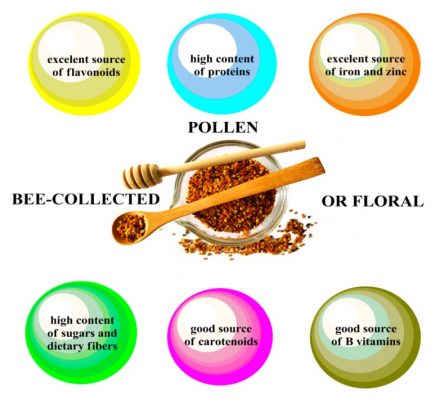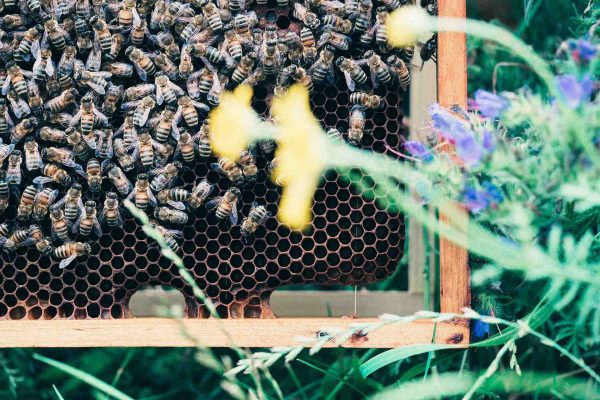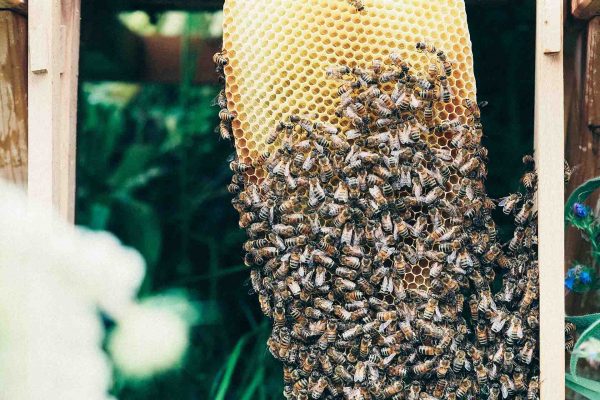At BeesMAX we are now what is generally termed Chemical Free Beekeepers where we do not use any manufactured products to treat bee diseases.
Other Chemical Free Beekeepers use other disease intervention processes but not as much garlic as we do.
There are other invasive preventative measures available to help reduce diseases but when any notifiable diseases are or may be present in our colonies of bees then all the usual legal requirements of the governments bee inspectors are rigorously followed.
Why our bees are fed allicin from crushed garlic
As Chemical Free Beekeepers we rely solely on allicin from crushed garlic. We feed the colonies on a periodic basis with this infused mix of crushed garlic in the sugar syrup both as a medication and as extra flight fuel.
Sugar does not make them stay-at-home lazy bees but merely helps them go out to forage without further denuding their existing stocks of honey and pollen. Usually, the more they fly the quicker their honey stock reduces and so foraging becomes a balancing act for them.
Knowing when a flying day will be productive enough to get enough nectar to increase their food stocks in the hives and not erode the stocks to such a point they begin to starve.
The ingested garlic doesn’t pass to the honey
The honey we bottle does not contain garlic within it as we would smell it straight away. Normally, when beekeepers feed sugar syrup to their bees there is no associated smell so feeding procedures for separation from the bottled honey is more difficult. That is another reason why we use garlic in all our sugar syrup fed to our bees to make sure that contamination does not happen.
Why using allicin helps keep the bees healthy
It is important for beekeepers to prevent the growth of unwanted bacteria (pathogens) in beehives, otherwise, the bees can get infected and may also lead them to die.
An alternative way to achieve this is to use harmless (when used in the correct concentrations) substances, specifically, allicin. Allicin is a chemical compound derived from garlic. It is known to be effective against human food-born pathogens by inhibiting their growth.
Understanding the research behind allicin and bees
Within this blog we explore a few research studies that investigated the effect of allicin against microbes that can negatively affect honeybees.
We are particularly interested in this since reading a book on the subject a few years ago. Since then we have tested allicin’s effectiveness at controlling honeybee health and have now moved away from administering manufactured medicines to purely using this homeopathic alternative.
We at BeesMAX are now practising chemical free honeybee husbandry that relies upon the colony’s ability to withstand disease.
The only exceptions are where American or European Foul Brood is suspected and immediate advice and inspection is sought from the National Bee Inspection Service.
This blog does not cover all the benefits honeybees derive from the use of allicin and more information will be published as we discover it.
Understanding the properties of Allicin and making use of it
It is important to understand the properties of allicin in order make use of its antimicrobial effects correctly.
Allicin is not present in raw garlic, rather, it is derived from it. This works through the rapid production of enzyme CS-lyase (allinase) on the raw compound: alliin.
Garlic cloves contain approximately 8g/kg of alliin. Most of the alliin is not lost during a dehydration process, since garlic powders contain 10 g/kg of it. Crushing or cutting garlic cloves activates the allinase enzyme to convert alliin into allicin, which is a high amount at around 37mg/g. (Rahman, 2007)
Allicin was studied and found to undergo dehydration and causes a build-up of disulphides. It was found that sulphur dioxide, diallyl mono-, di- and trisulfides were products of tis reaction. This could suggest that it is important to keep the garlic in water after crushing it to prevent chemicals, which effects may be unknown to bees, forming in a sugar syrup solution (Brodnitz, Pascale and Derslice, 1971).
Use of allicin against honeybee pathogens
A study by Aronstein and Hayes (2015) explores the antimicrobial activity of allicin liquid and was tested against different bacterial and fungal pathogens detrimental to social and solitary bees. They had investigated the minimum inhibitory conditions (MIC) of the pathogens using a microdilution method, within a range of 1000 ppm to 25 ppm. The effectiveness of allicin against microbes were also tested in agar diffusion test with 250 μg of Allicin per disk
The allicin liquid had shown antimicrobial activity against gram-positive bacterial isolates at MIC 350 ppm, and fungal isolates at MIC 250 ppm.
Their results were “Bacterial isolates (P. I. pulvifaciens and P. I. larvae) were associated with zones of inhibition in the range of 24–26 mm and 45–50 mm, respectively. The fungal isolates were associated with zones of inhibition in the range of 31–35 mm (A. apis) and 35–37 mm”.
They conclude that the data from this study suggest the effectiveness of allicin to inhibit growth of bee pathogens and “reduce occurrence of at least two major bee diseases.”
Against ascospherosis (chalkbrood disease)
Ascospherosis (or chalkbrood) is a disease caused by Ascosphaera apis fungus, and affects honeybees. It is said to cause the death of larvae and in extreme cases, the death of adult bees and loss of productivity in the colony (Kloucek et al., 2012).
A study in Russia had aimed to investigate the use of an “environmentally safe preventive remedy against ascospherosis,” which included allicin in garlic (Liubimov et al., 2020).
This study by Luibimov et al. (2020) had investigated the effectiveness of compounds from natural raw materials against this disease using two experimental groups. Each group were tested different compounds; group 1 were applied garlic, woodworm with vitamin C. Group 2 were applied garlic and iodine solution. They grew the fungi in petri dishes.
When retrieving the dishes for the results and analysis, they had found that the “solution consisting of garlic and iodine components, an insignificant demonstration of colony growth in the treated Petri dish was revealed, in the amount of 5%. When using an experimental solution (garlic, wormwood and ascorbic acid), the presence of fungus was detected in the amount of 14%, while a continuous growth of the fungus over 80% was observed in untreated Petri dish.” (Liubimov et al., 2020).
This showed that the garlic and iodine solution had highest effectiveness and allicin reduces the infection of the bee brood. This could be implemented as it will lead to an increase of the number of working flying bees.
Reducing attack from Varroa
We have over time found that regular treatment with Garlic has significantly reduce infestations of the Varroa Mite. We have regularly conducted varroa counts discovered that although not always cured entirely numbers are kept to a minimum or not visible in the colony. We have kept an eye out for Deformed Wing Disease (DFD) which is a sign of advanced numbers and long term infestation and so far we have only found about 1 in 25 colonies having DFD.
Further Reading (research sources):
- Allicin and Other Functional Active Components in Garlic: Health Benefits and Bioavailability
- Flavor components of garlic extract
- Antimicrobial activity of allicin against honey bee pathogens
- Determination of minimum inhibitory concentrations
- Use of environmentally safe preventive remedy against ascospherosis



